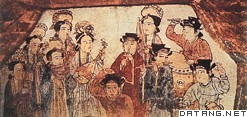1) Wei Le San


胃乐散
1.
Metheds The effects of Wei Le San on pylorus ligation induce , acetic acid induce and reserpine induce gastric ulcers models were investigated respectively .
目的 研究胃乐散对急、慢性三种实验性溃疡模型的作用。
2) Weile


胃乐
1.
Objective:To further investigate the pathogenesis of chronic atrophic gastritis(CAG) and the mechanism in treating CAG by TCM formula Ganpingyangwei and Weile from the point of view of enzyme histochemistry and ultrastructure.
目的 :从酶组化及超微结构角度进一步探讨慢性萎缩性胃炎 (CAG)发病机制及“甘平养胃”、“胃乐”方剂治疗 CAG机制。
3) Veytalo Tablet


胃得乐,胃乐
4) Roter


乐得胃 ,乐得 ,乐胃,胃速乐
5) San Yue


散乐
1.
“Lu Qi”,Whose source can trace back to pre-Qin,was often called“San Yue”in classics.


路歧,考其渊源,可上溯至远古时期,在典籍中常被称作“散乐”。
2.
Especially,having had the aid of the silk road of the sea,rich and varied San Yue(a type of operas so called as a joint name originates from the folk songs and dances) and ZaXi(poetic drama set to music),were graduately transfered into ancient Japan,This promoted greatly the formation and the development of the ancient Japane.
尤其是在泱泱大唐时期 ,借助于“海上丝绸之路”,华夏中原与西域丰富多彩的散乐、百戏、杂剧漂洋过海东渐古代日本 ,有力地促进了此岛国能乐、狂言、歌舞伎、木偶剧、假面剧等古典乐舞戏艺术的形成与发
6) Weile Capsule


胃乐胶囊
1.
Determination of Glycyrrhetinic Acid in Weile Capsule by RP-HPLC;


反相高效液相色谱法测定胃乐胶囊中甘草次酸含量
2.
OBJECTIVE:To establish HPLC method for determination of the content of paeoniflorin in Weile capsules.
目的 :建立以高效液相色谱法测定胃乐胶囊中芍药苷含量的方法。
补充资料:散乐百戏
| 散乐百戏 中国古代多种艺术和娱乐表演品种的泛称。包括歌舞、器乐、角抵、武术、杂技、魔术及杂剧等。娱乐性的艺术与多种技艺的表演形式在先秦时即已出现,当时表演场所以宫廷为中心。汉代出现百戏一词,其内容多种多样,有歌唱奏乐的化装表演,也有各种杂技项目以及马戏、驯兽、魔术等,在表演中常以俗乐伴奏。南北朝时期,百戏的表演场所已扩展至寺庙。经隋 、唐的发展,宋代散乐百戏的品种已达100多种,表演的场所也进一步扩展到城市瓦肆。当时已有北宋杂剧、金院本、傀儡戏等戏曲萌芽形式的兴起和盛行。元、明、清时期,成熟的戏曲吸收了多种散乐百戏的技艺,同时这些品种经独立发展后有了专称,作为泛称的散乐百戏已渐少使用。
|
说明:补充资料仅用于学习参考,请勿用于其它任何用途。
参考词条
